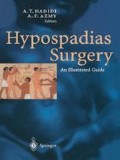Abstract
Most estimates of prevalence of hypospadias in Europe and the USA range up to a maximum of 3 per 1,000 births, with two-thirds to three-quarters of cases being glanular or coronal (Table 3.1).
Access this chapter
Tax calculation will be finalised at checkout
Purchases are for personal use only
Preview
Unable to display preview. Download preview PDF.
References
Aho M, Koivisto A-M, Tammela TLJ, et al: Is the incidence of hypospadias increasing? Analysis of Finnish Hospital Discharge Data 1970–1994. Environ Health Perspect. 2000; 108:463–465.
Baskin LS, Hirnes K, Colborn T: Hypospadias and endocrine disruption: is there a connection? Environ Health Perspect. 2001;109:1175–1183.
Burdorf A, Nieuwenhuisen MJ: Endocrine disrupting chemicals and human reproduction: fact or fiction? Ann Occup Hyg. 1999; 43:435–437.
Calzolari E, Contiero MR, Roncarati E, et al: Aetiological factors in hypospadias. J Med Genet. 1986; 23:333–337.
Chambers EL, Malone PSJ: The incidence of hypospadias in two English cities: a case-control comparison of possible causal factors. BJU Int. 1999; 84:95–98.
Choi J, Cooper KL, Hensle TW, et al: Incidence and surgical repair rates of hypospadias in New York State. Pediatr Urol. 2001; 57:151–153.
Colborn T: Environmental estrogens: health implications for humans and wildlife. Environ Health Perspect. 1995; 103 [Suppl7]:135–136.
Czeizel A: Increasing morbidity in the male reproductive system. Lancet. 1985; 1:462–463.
Dolk H: Rise in prevalence of hypospadias. Lancet. 1998; 351:770.
Dolk H, Vrijheid M, Armstrong B, et al: Risk of congenital anomalies near hazardous-waste landfill sites in Europe: The EUROHAZCON Study. Lancet. 1998; 352:423–427.
EUROCAT Working Group: EUROCAT Special Report, an assessment and analysis of existing surveillance data on hypospadias in UK and Europe, University of Ulster, 2002a.
EUROCAT Working Group: EUROCAT Report 8. Surveillance of congenital anomalies in Europe 1980–1999, University of Ulster, 2002b.
Fichtner J, Filipas D, Mottrie AM, et al: Analysis of meatal location in 500 men: wide variation questions the need for meatal advancement in all pediatric anterior hypospadias cases. J Urol. 1995; 154:833–834.
Fritz G, Czeizel AE: Abnormal sperm morphology and function in the fathers of hypospadias. J Reprod Fertil. 1996; 106:63–66.
Gallentin ML, Moreu AF, Thompson IM Jr: Hypospadias: a contemporary epidemiologic assessment. Pediatr Urol. 2001; 57:788–790.
Garcia AM, Fletcher T, BenafVides FG, et al: Parental agricultural work and selected congenital malformations. Am J Epidemiol. 1999; 149:64–74.
Henderson BE, Benton B, Cosgrove M, et al: Urogenital tract abnormalities in sons of women treated with diethylstil-bestrol. Pediatrics. 1976; 58:505–507.
Irgens A, Kruger K, Skorve AH, et al: Birth defects and paternal occupational exposure. Hypotheses tested in a record linkage based dataset. Acta Obstet Gynecol Scand. 2000; 79(6):465–470.
Joffe M: Are problems with male reproductive health caused by endocrine disruption? Occup Environ Med. 2001; 58: 281–288.
Kallen B, Winberg J: An Epidemiological study of hypospadias in Sweden. Acta Paediatr Scand. 1982; 293 [Suppl]: 1–21.
Kallen B, Bertollin R, Castilla E, et al: A joint international study on the epidemiology of hypospadias. Acta Paediatr Scand. 1986; 324 [Suppl]:5–52.
Kallen B, Castilla EE, Kringelbach M, et al: Parental fertility and infant hypospadias: an international case-control study. Teratology. 1991; 44:629–634.
Klip H, Verloop J, Van Gool J, et al: Increased risk of hypospadias in male offspring of women exposed to diethyl-stilbestrol in utero. Paediatr Perinatal Epidemiol. 2001; 15:A1–A38.
Kristensen P, Irgens LM, Andersen A, et al: Birth defects among offspring of norwegian farmers, 1967–1991. Epidemiology. 1997; 8:537–544.
Matlay P, Beral V: Trends in congenital malformations of external genitalia. Lancet. 1985; 1:108.
McDowell ME: Occupational reproductive epidemiology: the use of routinely collected statistics in England & Wales, 1980–1982. Stud Med Popul Subj no 50, HMSO, 1985.
Moller H, Weidner IS: Epidemiology of cryptorchidism and hypospadias. Epidemiology. 1999; 10:352–354.
North K, Golding J, The ALSPAC Study Team: A maternal vegetarian diet in pregnancy is associated with hypospadias. BJU Int. 2000; 85:107–113.
Olshan AF, Teschke K, Baird PA: Paternal occupation and congenital anomalies in offspring. Am J Ind Med. 1991; 20:447–475.
Paulozzi LJ: International trends in rates of hypospadias and cryptorchidism. Environ Health Perspect. 1999; 107:297–302.
Paulozzi LJ, Erickson JD, Jackson RJ: Hypospadias trends in two US surveillance systems. Pediatrics. 1997; 100:831–834.
Pierik FH, Burdorf A, Nijman JMR, et al: A high hypospadias rate in the Netherlands. Hum Reprod. 2002; 17:1112–1115.
Raman-Wilms L, Linin Tseng A, Wignardt S, et al: Fetal genital effects of first-trimester sex hormone exposure: a meta-analysis. Obstet Gynecol. 1995; 85:141–149.
Riley MM, Halliday JL, Lumley JM: Congenital malformations in Victoria, Australia 1983–1995: an overview of infant characteristics. J Paediatr Child Health. 1998; 34:233–240.
Schwartz DA, Newsum LA, Markowitz Heifetz R: Parental occupation and birth outcome in an agricultural community. Scand J Work Environ Health. 1986; 12:51–54.
Sharpe RM, Skakkebaek NE: Are oestrogens involved in falling sperm counts and disorders of the male reproductive tract? Lancet. 1993; 341:1392–1395.
Silver RI, Rodriguez R, Chang TS, et al: In Vitro fertilization is associated with an increased risk of hypospadias. J Urol. 1999; 161:1954–1957.
Stoll C, Alembik Y, Roth MP, et al: Genetic and environmental factors in hypospadias. J Med Genet. 1990; 27:559–563.
Sweet RA, Schrott HG, Kurland R, et al: Study of the incidence of hypospadias in Rochester, Minnesota, 1940–1970, and a case-control comparison of possible aetiological factors. Mayo Clin Proc. 1974; 49:52–58.
Toppari J, Larsen JC, Chrostiansen P, et al: Male reproductive health and environmental xenoestrogens. Environ Health Perspect. 1996; 104 [Suppl4]:741–803.
Vrijheid M, Dolk H, Armstrong B, et al: Hazard potential ranking of landfill sites and risk of congenital anomalies. Occup Environ Epidemiol. 2002; 59:768–776.
Weidner IS, Moller H, Jensen TK, et al: Cryptorchidism and hypospadias in sons of gardeners and farmers. Environ Health Perspect. 1998; 106:793–796.
Editor information
Editors and Affiliations
Rights and permissions
Copyright information
© 2004 Springer-Verlag Berlin Heidelberg
About this chapter
Cite this chapter
Dolk, H. (2004). Epidemiology of Hypospadias. In: Hadidi, A.T., Azmy, A.F. (eds) Hypospadias Surgery. Springer, Berlin, Heidelberg. https://doi.org/10.1007/978-3-662-07841-9_3
Download citation
DOI: https://doi.org/10.1007/978-3-662-07841-9_3
Publisher Name: Springer, Berlin, Heidelberg
Print ISBN: 978-3-662-07843-3
Online ISBN: 978-3-662-07841-9
eBook Packages: Springer Book Archive

